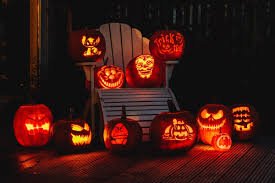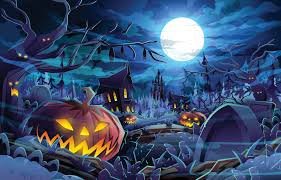Today we are going to talk about History of Halloween in this article.
Halloween has its roots in a long ago Celtic holiday where costumed revellers lighted bonfires to stave off spirits.
As a result, the custom is still practised today, with people dressing up in costumes, giving each other candy.
It is a holiday commemorated annually on October 31 to mark the night of the Christian feast of All Hallows’ Day (Feast of All Saints), observed in honour of all the saints of the church.
The majority of academics concur that Halloween as we know it dates back to some 2,000 years ago, when Celtic people in Europe celebrated Samhai, a festival that marked the end of the harvest and the beginning of a new year.

It is mostly honoured in western countries.
What does it means basically?
The origin of the modern English name can be found in mediaeval Christianity.
The Middle and Old English terms meaning holy are where the word hallow comes from.
It also has the noun meaning of saint.
The day before All Hallows’ Eve, when an evening mass was held, was All Hallows’ Eve, and it was the Christian celebration we now know as All Saints’ Day.
While the festival is still far from as popular as it is in the United States and Canada, It has become more and more popular in other European nations including England, France, and Germany.
Holidays honouring loved ones who have passed away are celebrated in many other nations.
Three rules of this festival :NEVER blow out a Jack O’Lantern before midnight. Always respect the Dead. Always check your candy.
The custom of Halloween, also known as Hallowe’en (a contraction of “All Hallows’ evening”), is said by historians to have its roots in an old Celtic festival where people lighted
bonfires and donned costumes to stave off spirits.
As a result, people still dress up for it, hand out candy to one another as part of “trick-or-treating,” carve pumpkins, and generally gather in a festive manner in order to stave off evil.
One idea holds that the origin of Halloween may be traced back to the ancient Celtic festival of Samhain, which commemorated the conclusion of a bountiful summer harvest and the start of the “dark, cold winter,” which at the time was associated with death and decay.
Thus, the Celts celebrated Samhain on the night that marked the transition from summer to winter.
They did this by building enormous bonfires in honour of their gods and making sacrifices in order to ward off evil spirits throughout the upcoming winter.
Some academics argue that All Hallow’s Day originated as a Christian celebration while others contend that the ritual, which has pagan roots and celebrates Samhain, was later Christianized.
Samhain was a strong and unique demon of Hell who was one of the 66 Seals and is also known as the beginning of Halloween.
Only after three days of blood sacrifices, with the ultimate sacrifice taking place on the last harvest’s , could he be raised by two strong witches.

The tradition evolved as follows in several of the western nations where it was practised.
On the evening of October 31, Halloween, also known as Hallowe’en, is now observed worldwide.
Why it is celebrated on October 31st?
Some of our secular Halloween customs are said to have their earliest known roots in the old Gaelic holiday of Samhain, which began the night before November 1 and took place on that day. More importantly, observers thought the veil between this world and the hereafter thinned at that time of year, allowing them to communicate with the dead. This period of time signified a turning point in the year when the seasons changed. The “haunted” notion of Halloween also originates from this.
It is a little more difficult to get to Christian Halloween on October 31. Early in the seventh century, Pope Boniface IV dedicated the Pantheon in Rome to the saints, starting the holiday that is now known as All Saints Day. However, the occasion was May 13. Pope Gregory III modified the rites in the following century.
Today’s Halloween celebrations typically involve large groups of kids dressed in spooky costumes going door to door asking for “trick-or-treat.”
In order to prevent whatever nefarious schemes these young miscreants may have concocted, scared households typically hand out enormous quantities of gifts in the shape of chocolates, candies, and candy.
But these festivals have their roots in paganism, which dates back a very long time.
The ancient Celtic celebration of Samhain is where Halloween got its start.
The Celts inhabited the regions that are today known as northern France, Britain, and Ireland until 2,000 years ago. The Pre-Christian Celts were primarily an agricultural and farming people.
Large bonfires were lit in every hamlet to fend off any evil spirits that might also be out in the open since it was thought by the Celts that on the night of October 31, the ghosts of their deceased would return to the mortal world.

Druids, or Celtic priests, would have presided over the Samhain festivities.
The Druids would have also seen to it that the hearth fires of each home were relit from the blazing embers of the sacred bonfire, helping to safeguard the populace and keep them warm throughout the impending long, dark winter.
When the Romans arrived from mainland Europe in 43 AD, they took control of a large portion of the Celtic tribal areas, and throughout the next 400 years of occupation and rule, they seem to have integrated many of their own celebrations into the pre-existing Celtic festivals.
One such illustration might assist in elucidating the present Halloween custom of “bobbing” for apples.
Pomona (shown to the right) was the Roman goddess of fruit and trees, and the apple just so happened to be her emblem.
The ancient esoteric rites gave way to more jovial fun and games.
For instance, the more jovial concept of telling the future was used in place of the fairly serious concept of connecting to the dead.
On All Hallows’ Eve, for instance, the game of “bob for apples” gained popularity as a form of fortune telling. Apples would be chosen to represent all of a woman’s suitors, and the guy—er, apple—she would ultimately bite into would be said to indicate her future husband.
In fact, young ladies in the 19th century had a huge (though somewhat superstitious) opportunity to meet men on Halloween.
In the early fifth century, after the Romans left Britain, a new group of conquerors started to arrive.
The south and east shores of England were invaded by early Saxon warriors.
Following these early Saxon incursions, a large number of Germanic migrants—including Jutes from the Jutland peninsula (today Denmark), Angles from Angeln in southwest Jutland, and Saxons from northwest Germany arrived in east and southeast England starting around AD430.
The original Celtic tribes of Britain were driven to the country’s northern and westernmost regions, including what are now Wales, Scotland, Cornwall, Cumbria, and the Isle of Man.
A new religion also migrated to Britain in the decades that followed.
With the arrival of Saint Augustine from Rome in 597, Christian teaching and faith began to expand from those northern and western extremes, coming from the early Celtic Church, and up from Kent.
The Christian Festivals, including “All Hallows’ Day,” also known as “All Saints Day,” a day to memorialise those who had perished for their beliefs, came with the Christians.
In the eighth century, Pope Gregory ordered the date of the All Hallows’ feast to be changed from May 13 to November 1.
It’s believed that he was trying to replace or incorporate the Celtic Samhain holiday of the dead with a similar but church-approved celebration when he did this.
As a result, Samhain’s night or evening became known as All Hallows’ Eve, then Hallowe’en, and finally, of course.
A unique time of the year, a night when magic is most powerful, when many people think that the spirit world can communicate with the material world.

It has long been a holiday in Britain marked by activities for kids like bobbing for apples in water-filled jars, reading ghost stories, and carving faces into hollowed-out vegetables like swedes and turnips.
In order to ward off any evil spirits, these faces would typically have candles burning inside of them, which were then put on window sills.
In the same way that the present use of pumpkins is a relatively recent import from the United States, we owe our American friends a debt of gratitude for the ‘cute’ “trick-or-treat” custom!
It was rumoured that many people would dress up as saints and sing or read poetry door to door. Additionally, kids would knock on doors and ask for “soul cakes,” a dessert resembling biscuits. Technical note: Soul cakes were originally associated with the All Souls’ Day holiday on November 2 (yes, a third holiday after Halloween and All Saints’ Day! ), but as trick-or-treating expanded, they finally became a component of Halloween night. In order to protect their kids from holiday pranks, families would give them treats in the early to mid-1900s, which helped popularise the candy-grabbing concept.




